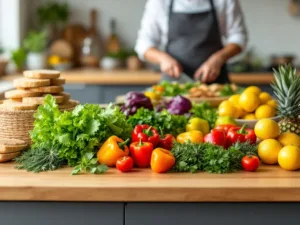How to Prepare Healthy Food Without Using Salt: A Comprehensive Guide to Flavorful, Low-Sodium Cooking
In a world where processed foods and fast meals dominate our diets, salt has become an omnipresent ingredient. While it enhances flavor, excessive salt consumption is linked to serious health issues such as hypertension, heart disease, and kidney problems. The World Health Organization (WHO) recommends consuming less than 5 grams of salt per day, yet many people far exceed this limit. But what if you could prepare delicious, healthy meals without relying on salt? This article explores practical strategies, alternative ingredients, and creative cooking techniques to help you reduce sodium intake without sacrificing taste. Whether you’re managing a health condition or simply aiming for a healthier lifestyle, this guide will empower you to cook flavorful, salt-free meals with confidence.
The Health Risks of Excessive Salt Consumption
Before diving into salt-free cooking, it’s essential to understand why reducing salt intake is crucial. Sodium, a key component of salt, plays a vital role in maintaining fluid balance and nerve function. However, too much sodium can lead to:
- High Blood Pressure: Excess sodium causes the body to retain water, increasing blood volume and pressure on artery walls.
- Heart Disease: High blood pressure is a major risk factor for heart attacks and strokes.
- Kidney Damage: The kidneys struggle to filter excess sodium, potentially leading to chronic kidney disease.
- Osteoporosis: High sodium levels can cause calcium loss, weakening bones over time.
By reducing salt in your diet, you can significantly lower these risks and improve overall health.
Understanding the Role of Salt in Cooking
Salt is more than just a seasoning; it’s a flavor enhancer that amplifies the taste of other ingredients. It also plays a functional role in cooking, such as preserving food, tenderizing meat, and controlling yeast activity in baking. Removing salt entirely can feel daunting, but with the right techniques, you can achieve satisfying results.
Strategies for Cooking Without Salt
1. Embrace Herbs and Spices
Herbs and spices are the backbone of salt-free cooking. They add depth, complexity, and aroma to dishes without the need for sodium. Experiment with:
- Fresh Herbs: Basil, cilantro, parsley, dill, and mint.
- Dried Spices: Cumin, paprika, turmeric, cinnamon, and coriander.
- Aromatic Blends: Italian seasoning, curry powder, za’atar, or herbes de Provence.
Example: Replace salt in a roasted chicken recipe with a blend of rosemary, thyme, garlic powder, and black pepper.
2. Use Acidic Ingredients
Acidic ingredients like lemon juice, vinegar, and tomatoes can brighten flavors and compensate for the lack of salt. They add a tangy, refreshing note that enhances the overall taste of a dish.
- Lemon or Lime Juice: Perfect for salads, seafood, and grilled vegetables.
- Vinegars: Balsamic, apple cider, or rice vinegar can elevate dressings and marinades.
- Tomatoes: Fresh or canned tomatoes add natural umami and acidity to soups and stews.
Tip: Add a splash of lemon juice to steamed broccoli or a drizzle of balsamic vinegar over roasted Brussels sprouts.
3. Incorporate Umami-Rich Ingredients
Umami, the fifth taste, is often described as savory or meaty. Incorporating umami-rich ingredients can make salt-free dishes more satisfying.
- Mushrooms: Fresh or dried mushrooms add depth to soups and stir-fries.
- Tomato Paste: A concentrated source of umami for sauces and stews.
- Nutritional Yeast: A cheesy, nutty flavor enhancer for vegan dishes.
- Soy Sauce (Low-Sodium): Use sparingly for a salty kick without excessive sodium.
Example: Add sautéed mushrooms and a teaspoon of tomato paste to a vegetable stew for a rich, savory flavor.
4. Experiment with Aromatics
Aromatics like garlic, onions, ginger, and shallots form the foundation of many dishes. They add layers of flavor that reduce the need for salt.
- Garlic: Roast or sauté garlic to bring out its sweetness.
- Onions: Caramelize onions for a rich, sweet base in soups and sauces.
- Ginger: Fresh ginger adds warmth and zest to Asian-inspired dishes.
Tip: Sauté minced garlic and onions in olive oil as a base for pasta sauces or casseroles.
5. Opt for Homemade Stocks and Broths
Store-bought stocks and broths are often high in sodium. Making your own allows you to control the ingredients and flavor.
- Vegetable Stock: Simmer carrots, celery, onions, and herbs in water for an hour.
- Chicken or Beef Stock: Use bones, vegetables, and spices for a rich, flavorful base.
Example: Use homemade stock as a base for soups, risottos, and grain dishes.
6. Toast and Roast for Depth
Toasting spices and roasting vegetables or proteins can intensify their natural flavors, reducing the need for added salt.
- Toasting Spices: Heat cumin seeds or coriander in a dry pan until fragrant.
- Roasting Vegetables: Roast carrots, sweet potatoes, or cauliflower to bring out their sweetness.
Tip: Toss vegetables with olive oil, black pepper, and smoked paprika before roasting.
7. Choose Fresh, Whole Ingredients
Processed foods are often loaded with hidden sodium. By focusing on fresh, whole ingredients, you can naturally reduce your salt intake.
- Fresh Produce: Fruits, vegetables, and herbs.
- Whole Grains: Brown rice, quinoa, and oats.
- Lean Proteins: Chicken, fish, tofu, and legumes.
Example: Build a salad with fresh greens, grilled chicken, quinoa, and a lemon-tahini dressing.
8. Get Creative with Salt Substitutes
While some salt substitutes contain potassium chloride, which can be problematic for certain individuals, others rely on natural ingredients to mimic saltiness.
- Seaweed: Dried seaweed flakes add a briny, salty flavor.
- Himalayan Pink Salt: While still a form of salt, it contains trace minerals and can be used sparingly.
- Citrus Zest: Grated lemon or lime zest can add a burst of flavor.
Tip: Sprinkle a small amount of seaweed flakes over popcorn or roasted nuts for a salty taste.
Practical Tips for Transitioning to Salt-Free Cooking
- Start Gradually: Reduce salt incrementally to allow your taste buds to adjust.
- Read Labels: Check sodium content on packaged foods and choose low-sodium options.
- Cook at Home: Preparing meals from scratch gives you full control over ingredients.
- Stay Hydrated: Drinking water helps flush excess sodium from your body.
- Be Patient: It may take time to appreciate the natural flavors of salt-free dishes.
Sample Salt-Free Recipes
1. Herb-Roasted Chicken
- Rub a whole chicken with olive oil, minced garlic, rosemary, thyme, and black pepper.
- Roast at 375°F (190°C) for 1.5 hours or until the internal temperature reaches 165°F (74°C).
2. Lemon-Garlic Quinoa Salad
- Cook quinoa according to package instructions.
- Toss with chopped cucumbers, cherry tomatoes, parsley, lemon juice, and minced garlic.
3. Spicy Black Bean Soup
- Sauté onions, garlic, and bell peppers in olive oil.
- Add black beans, diced tomatoes, cumin, chili powder, and vegetable stock.
- Simmer for 20 minutes and garnish with fresh cilantro.
Conclusion: Embracing a Salt-Free Lifestyle
Reducing salt in your diet doesn’t mean sacrificing flavor. By leveraging herbs, spices, acidic ingredients, and umami-rich foods, you can create delicious, healthy meals that satisfy your taste buds and support your well-being. The key is to experiment, be patient, and focus on fresh, whole ingredients. Over time, you’ll find that your palate adapts, and you’ll appreciate the natural flavors of food more than ever.
As you embark on your salt-free cooking journey, remember that small changes can lead to significant health benefits. Start with one meal at a time, and soon, you’ll master the art of preparing flavorful, low-sodium dishes that nourish your body and delight your senses.
By following these tips and techniques, you’ll not only reduce your sodium intake but also discover a world of vibrant, exciting flavors that make healthy eating a joy rather than a chore.









Add comment